LG GM-L239MTGL Owner's Manual
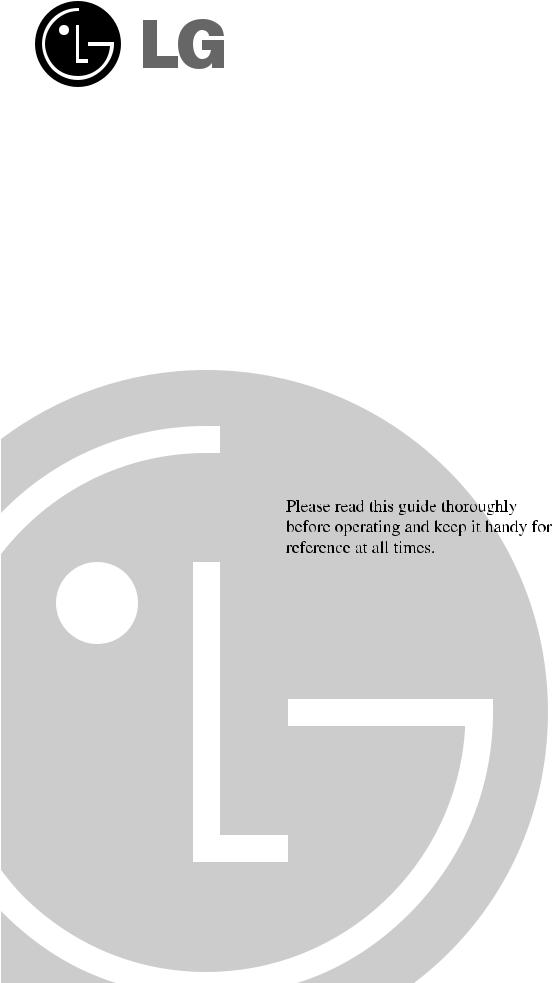
GM-L239MTGL, GM-L238MSGL
 REFRIGERATOR
REFRIGERATOR
Owner´s Manual
 REFRIGERADOR
REFRIGERADOR
Manual de Usuario
Lea detenidamente estas instrucciones antes de utilizar el refrigerador y guárdelas como referencia para el futuro.

TABLE OF CONTENTS
Important Safety Instructions |
3 |
Care and Cleaning |
17-19 |
|
Grounding Requirements |
4 |
General Cleaning Tips |
17 |
|
Refrigerator Features |
5 |
Outside |
17 |
|
Refrigerator Installation |
6 - 9 |
Inside Walls |
17 |
|
Unpacking you Refrigerator |
6 |
Door Liners and Gaskets |
17 |
|
Installation |
6 |
Plastic Parts |
17 |
|
Base Grille Installation |
6 |
Back Cover |
17 |
|
Handle Removal |
7 |
Lamp Replacement |
18-19 |
|
Removing and Replacing Refrigerator Doors |
7 - 8 |
Power Interruptions |
18 |
|
Door Alignment |
9 |
When you go on vacation |
18 |
|
Using Your Refrigerator |
10-16 |
When you move |
18 |
|
Ensuring Proper Air Circulation |
10 |
Operations Instructions |
19 |
|
Control Panel Features |
10-11 |
When You Should Set The Icemaker Power |
19 |
|
|
|
Switch To (off) |
||
Adjusting Control Settings |
11 |
Normal Sound you may Hear |
19 |
|
|
|
|||
Food Storage Guide |
12 |
Connecting the Water Line |
20-22 |
|
Storing Frozen Food |
12 |
|||
Before you begin |
20 |
|||
|
|
|||
Water Dispenser |
13 |
What you will need |
20 |
|
|
|
|||
Ice Storage Bin |
14 |
Installation Instructions |
21-22 |
|
|
|
|||
Icemaker cover |
14 |
Troubleshooting Guide |
23-27 |
|
Door Rack and Support |
14 |
|||
Warranty (U.S.A) |
28 |
|||
Crisper and Crisper cover |
14 |
|||
|
|
|||
Refrigerator Shelves |
15 |
|
|
|
Freezer Shelf |
15 |
|
|
|
Snack Pan |
16 |
|
|
|
Water Filter |
16 |
|
|
2

IMPORTANT SAFETY INSTRUCTIONS
This guide contains many important safety messages. Always read and obey.
This is the safety alert symbol. It alerts you to safety messages that inform you of hazards that can kill or hurt you or others, or cause damage to the product. All safety messages will be preceded by the safety alert symbol and the hazard signal word DANGER, WARNING, or CAUTION. These words mean:
You will be killed or seriously injured if you don’t follow instructions.

 You can be killed or seriously injured if you don’t follow instructions.
You can be killed or seriously injured if you don’t follow instructions.
Indicates an imminently hazardous situation which, if not avoided, may result in minor or moderate injury, or product damage only.
All safety messages will identify the hazard, tell you how to reduce the change of injury and tell you what can happe if the instructions are not followed.
 WARNING
WARNING
To reduce the risk of fire, electric shock or injury to persons when using your product, basic safety precautions should be followed, including the following. Read all instructions before using this appliance:
•NEVER unplug your refrigerator by pulling on the power cord. Always grip the plug firmly and pull it straight out from the outlet.
•Repair or replace immediately all electric service cords that have become frayed or otherwise damaged. Do not use a cord that shows cracks or abrasion damage along its length or at either the plug or connector end.
•When moving your refrigerator away from the wall, be careful not to roll over or damage it in any way.
•Do not crush or damage the water line.
•Do not store or use gasoline or other flammable (vapors or liquids) in the vicinity of this or any other appliance.
•Do not allow children to climb, stand or hang on the refrigerator doors or shelves in the refrigerator. They could damage the refrigerator and seriously injure themshelves.
•Keep fingers out of ‘pinch point’ areas; clearances between the doors and cabinet are necessarily small. Be careful when you open the doors when children are in the area.
•Unplug your refrigerator before cleaning or making any repairs.
NOTE: We strongly recommend that any servicing be performed by a qualified individual.
•Before replacing a burned-out light bulb, unplug the refrigerator or turn off power at the circuit breaker or fuse box in order to avoid contact with a live filament. (A burned-out light bulb may break when being replaced).
NOTE: Setting either or both controls to the OFF position does not remove power to the light circuit.
•Do not store bottles in the freezer compartment, they may break when frozen, causing damage.
•The refrigerator-freezer should be positioned so that supply plug is accessible for quick disconnection when accident happens.
•For personal safety, this appliance must be properly grounded. Have the wall outlet and the circuit checked by a qualified electrician to make sure the outlet is properly grounded.
•This refrigerator must be properly installed in accordance with the Attention Installer Instructions that were taped to the front of the refrigerator.
•After your refrigerator is in operation, do not touch the cold surfaces in the freezer compartment when hands are damp or wet. Skin may adhere to the extremely cold surfaces.
•In refrigerator with automatic icemakers, avoid contact with the moving parts of the ejector mechanism, or with the heating element that releases the cubes.
DO NOT place fingers or hands on the automatic ice making mechanism while the refrigerator is plugged in.
•DO NOT refreeze frozen foods which have thawed completely. The United States Department of Agriculture in Home and Garden Bulletin No. 69 says:
“...You may safely refreeze frozen foods that have thawed if they still contain ice crystals or if they are still cold below 40 °F (4 °C).”
“Thawed ground meats, poultry, or fish that have any off-odor or off-color should not be frozen and should not be eaten. Thawed ice cream should be discarded. If the odor or color of any food is poor or questionable, get rid of it. The food may be dangerous to eat.”
“Even partial thawing and refreezing reduces the eating quality of foods, particulary fruits, vegetables and prepared foods. The eating quality of red meats is affected less than that of many other foods. Use refrozen foods as soon as possible to save as much of their quality as you can.”
SAVE THESE INSTRUCTIONS
3

 DANGER: RISK OF CHILD ENTRAPMENT
DANGER: RISK OF CHILD ENTRAPMENT
Child entrapment and suffocation are not problems of the past. Junked or abandoned refrigerators are still dangerous… even if they will sit for “just a few days”. If you are getting rid of your old refrigerator, please
follow the instructions at right to help prevent accidents.
Before you throw away your old
Refrigerator or freezer:
•Take off the doors.
•Leave the shelves in place so that children may not easily climb inside.
This appliance is not intended for use by persons (including children) with reduced physical, sensory or mental capabilities, or lack of experience and knowledge, unless they have been given supervision or instruction concerning use of the appliance by a person responsible for their safety.
Children should be supervised to ensure that they do not play with the appliance.
CFC DISPOSAL
Your old refrigerator may have a cooling system that used CFCs (chlorofluorocarbons). CFCs are believed to harm stratospheric ozone. If you are throwing away your old refrigerator, make sure the CFC refrigerant is removed for proper disposal by a qualified servicer. If you intentionally release this CFC refrigerant, you can be subject to fines and imprisonment under provisions
of environmental legislation. This appliance contains fluid (refrigerant, lubricant), and is made of parts and materials which are reusable and / or recyclable. All the important materials should be sent to the collection center of waste material and can be reused after rework (recycling). To recycle, please contact your local agency.
GROUNDING REQUIREMENTS
IMPORTANT: Please read carefully.
TO CONNECT ELECTRICITY
 WARNING
WARNING
Electrical Shock Hazard
FOR PERSONAL SAFETY, this appliance must be properly grounded. Have the wall outlet and the circuit checked by a qualified electrician to make sure the outlet is properly grounded.
3-prong grounding type wall receptacle 
3-prong grounding plug
Ensure proper ground exists before use.
NOTE: Before performing any type of installation, cleaning, or removing a light bulb, turn the control (Thermostat, Refrigerator Control or Freezer Control, depending on the model) to OFF and then disconnect the refrigerator from the electrical source. When you are finished, reconnect the refrigerator to the electrical source and reset the control (thermostat, refrigerator control or freezer control, depending on the model) to the desired setting.
Where a standard two-prong wall outlet is encountered, it is your personal responsibility and obligation to have it replaced with a properly grounded three-prong wall outlet. Do not, under any circumstances, cut or remove the third (Ground) prong from the power cord.
USE OF EXTENSION CORD
Because of potential safety hazards under certain conditions, we strongly recommend against the use of an extension cord. However, if you still elect to use an extension cord, it is absolutely necessary that it be a UL-listed (in the United States), 3-wire grounding type appliance extension cord having a grounding type plug and outlet, and that the electrical rating of the cord be 15 A (minimum) and 120 V.
RECOMMENDED GROUNDING METHOD
The refrigerator should always be plugged into its own individual properly grounded electrical outlet rated for 127 V ~ 60 Hz, AC or 115 V ~ 60 Hz, AC (According to the National rating) only and fused at 15 or 20 A. This provides the best performance and also prevents overloading house wiring circuits which could cause a fire hazard from overheated wires. It is recommended that a separate circuit serving only this appliance be provided. Use a receptacle which cannot be turned off with a switch or pull chain. Do not use an extension cord.
Use of an extension cord will increase the clearance needed for the back of the refrigerator.
 WARNING
WARNING
POWER CORD REPLACEMENT
If the power cord is damaged, it must be replaced by the manufacturer, by our service center or by qualified personal by LG Electronics, to avoid some risk.
4
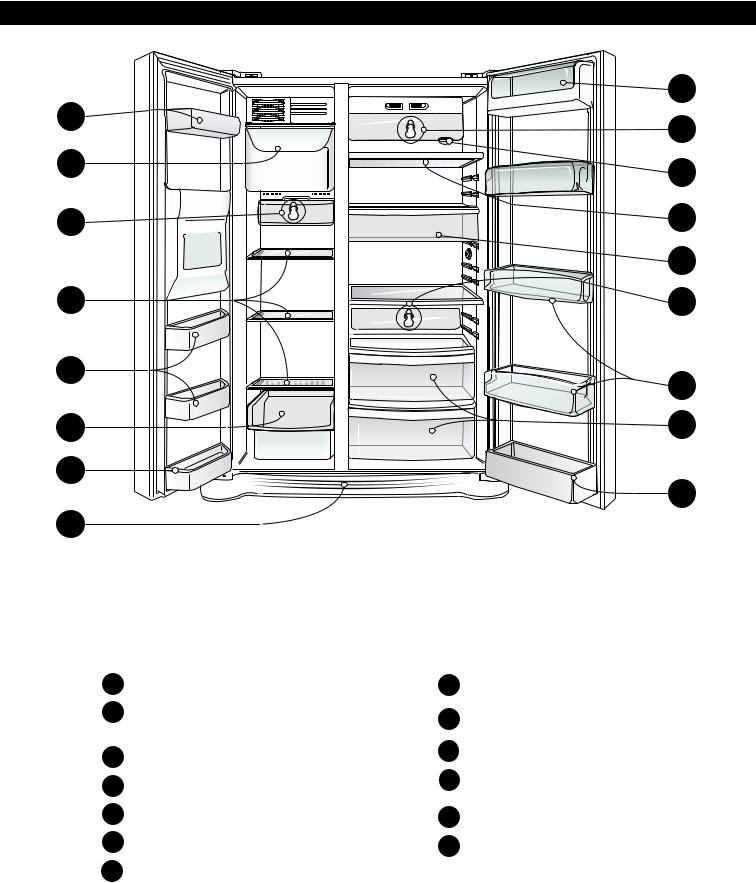
REFRIGERATOR FEATURES
A |
G |
|
H |
||
|
||
B |
I |
|
|
||
C |
J |
|
|
K |
|
D |
H |
|
A |
L |
|
|
||
E |
M |
|
A |
L |
|
|
||
F |
|
Use this page to become more familiar with the parts and features. Page references are included for your convenience.
Note: This guide covers several different models.The refrigerator you have purchased may have some or all of the items listed below. The locations of the features shown below may not match your model.
A Freezer Door Rack |
H Refrigerator Lamp |
B Automatic Icemaker |
I Water Filter |
The ice is produced in the icemaker |
and sent to the dispenser.
CFreezer Lamp
DFreezer Shelf
EDrawer
FBase Grille
G Dairy Corner
For storage of dairy products
such as butter and cheese.
JRefrigerator Shelf
KSnack Pan
For storage of meat or fresh food.
L Refrigerator Door Rack
M Vegetable Drawer
5
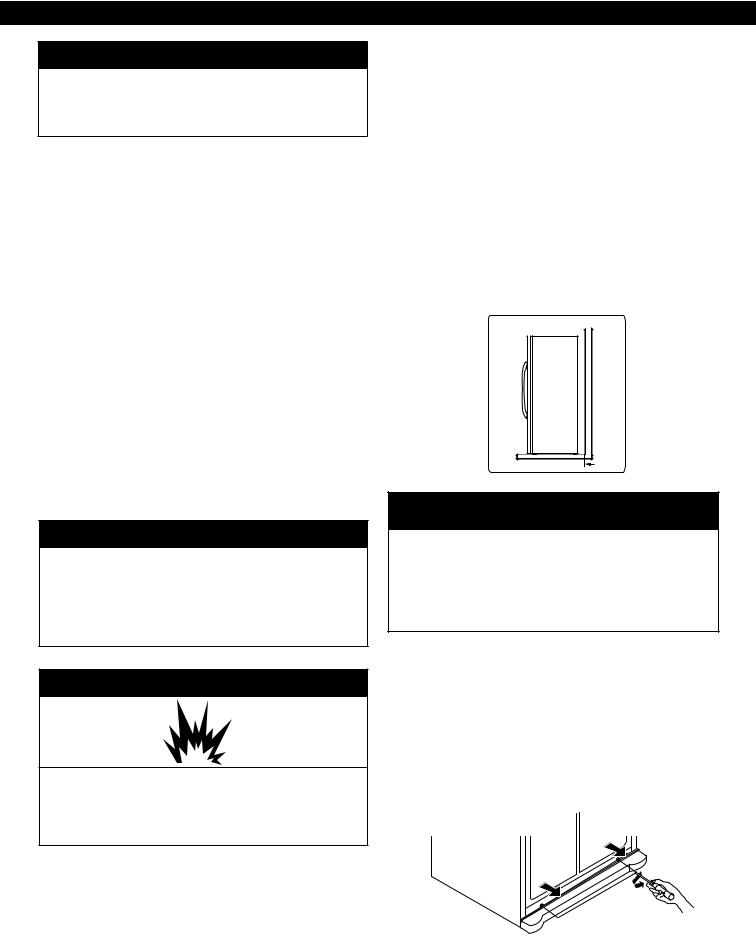
REFRIGERATOR INSTALLATION
 WARNING
WARNING
Excessive Weight Hazard
Use two or more people to move and install
Refrigerator.
Failure to do so can result in back or other injury.
UNPACKING YOUR REFRIGERATOR
Remove tape and any temporary labels from your refrigerator before using. Do not remove any warning type labels the model and serial number label.
To remove any remaining tape or glue, rub the area briskly with your thumb. Tape or glue residue can also be easily removed by rubbing a small amount of liquid dish soap over the adhesive with your fingers. Wipe with warm water and dry.
Do not use sharp instruments, rubbing alcohol, flammable fluids or abrasive cleaners to remove tape or glue. These products can damage the surface of your refrigerator. For more information, see the Important Safety Instructions section.
Refrigerator shelves are installed in the shipping position.
Please reinstall shelves according to your individual storage needs.
 WARNING
WARNING
When Moving Your Refrigerator:
Your refrigerator is heavy. When moving the refrigerator for cleaning or service, be sure to protect the floor. Always pull the refrigerator straight out when moving it. Do not wiggle or walk the refrigerator when trying to move it, as floor damage could occur.
INSTALLATION
1.Avoid placing unit near heat sources, direct sunlight or moisture.
2.To minimize noise and vibration, the refrigerator MUST be installed on a solidly constructed floor.
3.Carpeting and soft tile surfaces are not recommended.
4.NEVER install the refrigerator on a platform or a weakly supported structure.
5.Install this appliance in an area where the temperature is between 41 °F (5 °C) and 110 °F
(43 °C). If the temperature around the appliance is too low or high, cooling ability may be adverseley affected.
NOTE: For proper air circulation, best cooling and energy consumption results, maintain a minimum distance of 2 inches (5.08cm) from adjacent items and surfaces.
2” (5.08 cm) 

 WARNING
WARNING
•Be careful when you work with hinge, base grille, stopper, etc. You may be injured.
•Do not put hands or metal sticks into air vents, base grille or bottom or refrigerator. You may be injured or receive an electrical shock.
 WARNING
WARNING
Explosion Hazard
Keep flammable materials and vapors, such as gasoline, away from refrigerator.
Failure to do so can result in death, explosion or fire.
BASE GRILLE INSTALLATION
1.To remove the base grille:
a)Open the Doors. (Refrigerator and Freezer)
b)Once doors are open remove screws on top of cover.
2.To install or replace base grille:
a)Place cover into position and insert and tighten screws.
6

REFRIGERATOR INSTALLATION
HANDLE REMOVAL
NOTE: It is ALWAYS recommended to remove the refrigerator doors when it is necessary to move the refrigerator through a narrow opening. If necessary, follow the directions below to remove the door handles.
•Loosen the set screws with a 3/32” (2.38 mm) Allen wrench and remove the handle.
NOTE: If the handle mounting fasteners need to be tightened or moved, use a 1/4” (6.35 mm) Allen wrench.
 WARNING
WARNING
Electric Shock Hazard
•Disconnect electrical supply to the refrigerator before installing. Failure to do so could result in death or serious injury.
•Do not put hands or feet or other objects into the air vents, base grille, or bottom of the refrigerator. You may be injured or receive an electrical shock.
•Be careful when you work with the hinge, base grille, and stopper. You may be injured.
Mounting
fasteners
REMOVING AND REPLACING
REFRIGERATOR DOORS
Before remove the doors, remove the Base Grille.
See BASE GRILLE INSTALLATION for reference.
To remove the right (refrigerator) door:
(1)
Set screw
 (2)
(2)
|
(3) |
|
|
(4) |
|
|
(5) |
(3) |
|
|
|
|
|
Rivet |
Type 1 |
(4) |
(5) |
|
|
Type 2
Allen Wrench
1.Open the door. Remove the top hinge cover screw
(1).
2.Use a flat blade screwdriver to pry back the hooks (not shown) on the cabinet underside of the cover (2). Lift up the cover.
3.Rotate the hinge lever (3) clockwise. Lift the top hinge
(4) free of the hinge lever latch (5).
NOTE: Regardless the type of hinge lever (3); type1: without rivet or type 2: with rivet the removal process is the same.
4.Lift the door from the lower hinge pin.
5.Place the door, inside facing up, on a nonscratching surface.
CAUTION: When lifting the hinge free of the latch, be careful that the door does not fall forward.
7
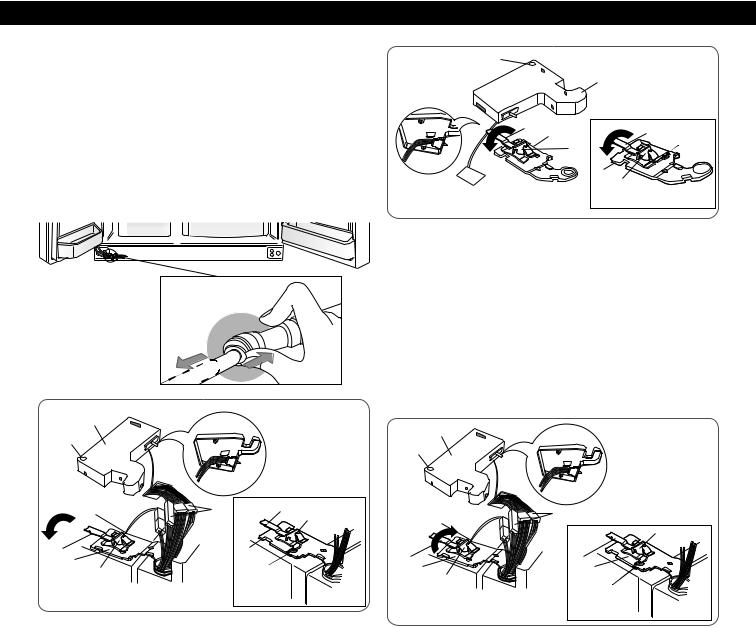
REFRIGERATOR INSTALLATION
Removing the left (freezer) door with water line connection.
•Pull up the water feed tube while pressing area (Figure 1) as shown in the figure below.
•NOTE:If a tube end is deformed or abraded, trim the part away. Disconnecting the tube under the door causes about 1.5 liters water to flow out. Put a large container at end of tube to prevent water from draining onto the floor.
(1)
|
(2) |
(3) |
(3) |
(4) |
|
(5) |
Rivet |
|
(4) |
|
(5) |
Type 1 |
Type 2 |
|
Figure 1 |
(2)
(1)
(4) |
(3) |
(5) |
|
|
(7) |
(5) |
|
(6) |
(6) |
|
Rivet |
(7) |
|
|
|
|
|
Type 1 |
|
Type 2 |
1.Open the door. Remove the top hinge cover screw (1).
2.Use a flat blade screwdriver to pry back the hooks (not shown) on the cabinet underside of the cover (2). Lift up the cover.
3.Disconnect all the wire harnesses (3).
4.Remove the grounding screw (4).
5.Rotate hinge lever (5) counterclockwise. Lift the top hinge (6) free of the hinge lever latch (7).
NOTE: Regardless the type of hinge lever (5); type1: without rivet or type 2: with rivet the removal process is the same.
 CAUTION: When lifting the hinge free of the latch, be careful that the door does not fall forward.
CAUTION: When lifting the hinge free of the latch, be careful that the door does not fall forward.
6.Lift the door from the lower hinge pin being careful to pull the water lines through the lower hinge pin.
7.Place the door, inside facing up, on a nonscratching surface.
Reinstalling the rigth (Refrigerator) door
1.Place the door onto the lower hinge pin.
2.Fit top hinge (4) over hinge lever latch (5) into place. Rotate lever (3) counterclockwise to secure hinge.
NOTE: Regardless the type of hinge lever (3); type1: without rivet or type 2: with rivet the removal process is the same.
3.Hook tab on switch side of corner under edge of wire opening in cabinet top. Position cover (2) into place. Insert and tighten cover screw (1).
(2) |
|
|
(1) |
|
|
(4) |
(3) |
|
(7) |
||
|
||
(5) |
(5) |
|
(6) |
(6) |
|
(7) |
Rivet |
|
|
||
Type 1 |
Type 2 |
Reinstalling the left (Freezer) door
1.Feed the water tubes through the lower hinge pin and place the door onto the lower hinge pin.
2.Fit top hinge (6) over hinge lever latch (7) and into place. Rotate lever (5) clockwise to secure hinge
NOTE: Regardless the type of hinge lever (5); type1: without rivet or type 2: with rivet the removal process is the same.
3.Install the grounding screw (4) and connect all the wire harnesses (3).
4.Hook tab on door switch side of cover (2) under edge of wire opening in cabinet top. Position cover into place. Insert and tighten cover screw (1).
5.Reconnect the water tubes by inserting the tubes into the connectors.
8
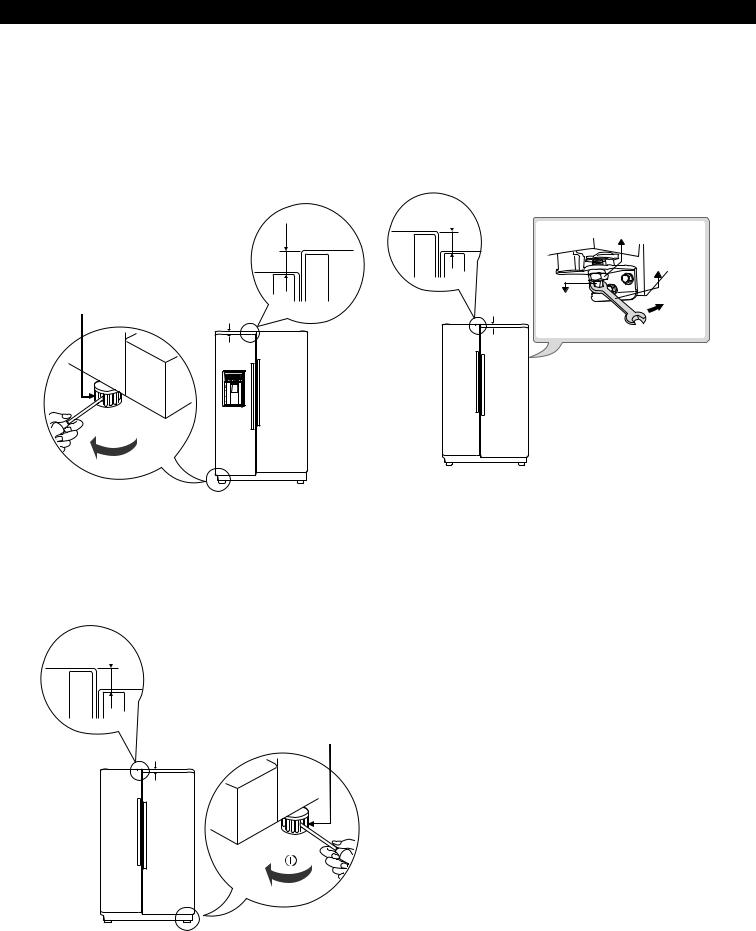
REFRIGERATOR INSTALLATION
DOOR ALIGNMENT
Before adjust the doors, remove the Base Grille. See BASE GRILLE INSTALLATION for reference.
If the freezer compartment door is lower than the refrigerator compartment door, make them level by inserting flat blade screwdriver into the groove of the left leveling leg and rotating it clockwise.
Height difference
Left leveling |
Height |
leg |
|
|
difference |
If the freezer compartment door is higher than the refrigerator compartment door, make them level by inserting flat blade screwdriver into the groove of the right leveling leg and rotating it clockwise.
Height difference
Left leveling leg
Height
difference
Adjust the level when the refrigerator door is lower than the freezer door during the installation of the refrigerator.
Tools you need
• Wrench 5/16 in (8 mm)
Height difference
|
|
Keeper nut |
|
|
Wrench |
Height |
Adjustment |
Up |
difference |
hinge pin |
|
|
|
Down
Using a ¾” (19 mm) wrench, turn the keeper nut clockwise to lossen the keeper nut.
Using a 5/16” (8 mm) wrench, turn the adjustment hinge pin clockwise or counterclockwise to level the refrigerator and freezer door.
After setting the level door, turn the keeper nut counterclockwise to tighten.
Do not over tightening the door adjustment screw. The hinge pin can be pulled out. (Adjustable range of height is a maximum of ½” (1.27 cm)).
AFTER LEVELING THE DOOR HEIGHT
Make sure the front leveling legs are completely touching the floor.
9
